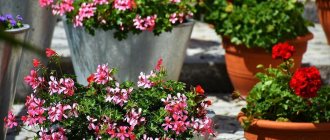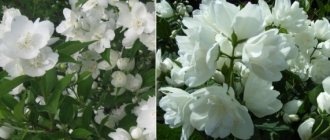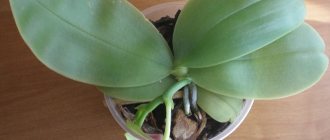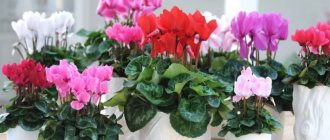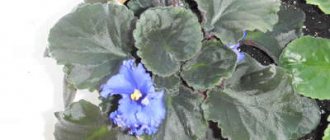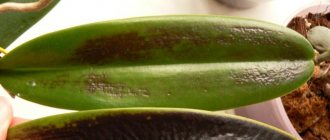Short description
Impatiens is a common indoor plant of the balsam family. It is very unpretentious in care, and also has very lush flowering, for which the British nicknamed it “Diligent Lizzie.” For another characteristic feature - the formation of droplets of moisture along the edge of the leaf - balsam is called “Vanka wet”. The official name of this plant is translated as “impatient”, because even with a slight touch, its fruits crack, scattering seeds.
Impatiens flowers are not very large, about 4 cm in diameter, and come in white, pink, red and yellow. Regularly shaped leaves in various shades of green. The bush is low from 40 to 60 cm. The fruit is a capsule.
Covered with color in winter and summer: how to make homemade Impatiens bloom throughout the year?
The ancestors of indoor balsams come from the African and Asian tropics - and numerous modern varieties with flowers of all shades and combinations of white, orange, red and purple have inherited from their “wild” ancestors the ability to bloom almost throughout the year .
In fact, the buds of a well-groomed plant open in the very early spring and continue to form and bloom until late autumn, which is already turning into winter.
Peculiarities
On a note. With the first days of spring, the plant begins to accumulate energy for the upcoming flowering.
Flower buds are laid, from which buds are formed. The plant's reproductive organs develop in the buds, and pollen matures for fertilization. Then the flower blooms. After the bud opens, some time passes before pollination, which at home, if you need to get seeds, will have to be done manually. Afterwards the flower withers and a fruit with seeds is formed.
Common diseases
Even if you live in an apartment, you cannot avoid some diseases. Infections are spread by pests, and the fungus can live in poor-quality soil. The table describes balsam diseases and their treatment.
Table - Diseases of balsam
| Name and cause of the disease | External manifestations | Treatment |
| Cucumber mosaic (virus) | – Leaves become wavy; – yellow spots and holes appear | – The plant is isolated and destroyed |
| Ring mosaic (virus) | – Round spots with a ring border appear on the foliage; – growth slows down; – leaves crack | |
| Brown rot (fungus) | – The stem becomes thin at the base and turns brown | – At the initial stages of the disease, they are sprayed repeatedly with the drug “Fitosporin”; – in case of severe damage, the balsam is destroyed |
| Downy mildew (fungus) | – Light spots form on the outside of the leaves; – the back side of the leaves is covered with a dirty whitish coating | – Trim the affected tissues; – sprayed with “Alyet” |
| Bacteriosis (bacteria) | – Black spots appear on the foliage | – Carry out pruning; – sprayed repeatedly with fungicides |
The necessary conditions
Even for an unpretentious plant, flowering is a very energy-intensive process and requires the following suitable conditions:
- The temperature must be maintained in the normal room range of 20 to 25 degrees. It is important to avoid sudden temperature changes and possible drafts.
- Lighting should be bright and long-lasting, with the exception of periods of scorching heat, when it is better to shade the plant.
- There are no strict restrictions on air humidity, but dry air near heating devices can interfere with the normal development of the plant. Therefore, the situation should be corrected by installing a tray with water over the pot, but the pot itself should be on a stand, without touching the bottom of the water.
- The container in which your balsam grows plays an important role. It must match the size of the plant's root system. The roots should not rest against the walls, but too much free space will not be beneficial. There should be drainage holes in the bottom of the pot for bottom watering and drainage of excess liquid.
- The soil should be light, porous, fertile, the reaction should be neutral or slightly acidic. In the store you can buy a soil mixture for begonias, which is also suitable for balsam. It is necessary to lay drainage under the soil, which will protect the roots from rotting.
Why indoor balsam does not bloom
In principle, balsam is unpretentious and will survive even in the most extreme conditions, but it will only grow leaf mass. There may be several objective factors why Vanka wet does not bloom.
Lighting
Coming from the south, where there is a lot of sun and long daylight hours, impatiens never bloom in shade. The buds, even if they are tied, are small and in small quantities. In addition, the plant most often discards them. When the level of illumination is insufficient, the overall vegetation slows down (the shoots become elongated, the greenery becomes pale and sluggish), because the processes of photosynthesis are not so intense.
To correct the situation, you will need to move Vanka wet to a place where there is enough natural daylight. But you still can’t put it under bright, burning rays, as the tender leaves will burn. If necessary, additional lighting is provided using fluorescent lamps or specialized phytolights.
Impatiens react extremely negatively to any movement in space. It's better not to touch it unnecessarily.
Temperature
For almost all tropical crops, including balsam, the optimal temperature is in the following ranges:
- +20…+25 °C – in the spring and summer months;
- not lower than +14…+16 °C - in the autumn-winter period.
If the temperature in the room does not fit within these limits, then flowering will inevitably suffer. Drafts that appear as a result of ventilation, as well as sudden temperature changes, have an extremely detrimental effect on the flowering of this crop.
In winter, you can’t put a wet Vanka too close to the window glass (allowing leaves to touch him), because he can’t stand the cold.
Air humidity
One of the most common reasons why balsam does not bloom or its buds fall off is too dry air in the room, which often happens during the heating season. It is recommended to spray the plant daily, affecting only the leaves and not getting on the buds, and also to increase the overall humidity by placing low bowls of water nearby.
If possible, in summer it is better to keep the bush in the fresh air (on the terrace, loggia, balcony, etc.).
Incorrectly selected pot
The planting container must exactly match the overall dimensions of the root system or be a little cramped. If there is free space in the pot, the balsam will try to quickly master it and will devote all its energy to developing roots, forgetting about flowering. In a container that is too small, the plant feels uncomfortable and restrained, and therefore does not produce flower stalks.
Improper watering
Fully justifying his nickname, Vanka the Wet loves moisture. It must be watered frequently (every 3-4 days in winter, once every 2 days in summer) and abundantly, ensuring that the substrate is completely wet. The remaining liquid that has drained into the pan is immediately removed. Swampiness is fraught with the development of putrefactive processes in the underground part, so water stagnation should not be allowed. The soil mixture should always be a little damp; it is unacceptable to overdry it completely, because the balsam instantly withers and drops its flowers.
Care Tips
Reference. It is not enough to provide the necessary conditions; the plant also needs to be properly cared for.
- Balsam requires abundant watering The soil should never dry out. However, the reverse error should also be excluded, when the soil is flooded to such an extent that it looks more like a swamp. The soil should always be slightly moist, but not wet. The best choice is watering through a tray; this option does not require you to estimate how much water is needed. You just need to place the pot in a container of water for 20-30 minutes. The water must be at room temperature.
- Fertilizing is required for flowering plants in pots. Otherwise, where will they get energy and all the necessary substances? You need to feed with complex mineral fertilizer for flowering plants. This is done every 10-14 days while the plant is blooming. Nitrogen fertilizing, on the contrary, can lead to a stop in flowering and the growth of leaves and shoots.
- Pinching , as well as removing faded buds, has a beneficial effect on flowering. However, it is worth remembering that each pinching delays the time of flowering. Pinching is done in the spring, shortening the main shoots. As a result, the plant will be more bushy, with short internodes, which means the flowering will be abundant. In this process, you can also remove shoots that are too long, weakened and unsightly. Just be careful not to overdo it so as not to stress the balsam too much.
- Transplantation is a necessary care measure. It is worth doing it as soon as the roots have completely mastered the earthen lump in the pot. But it is more advisable to do this at the same time every year, for example, in the spring. The new flowerware should be slightly larger than the old one, just a couple of centimeters in diameter.
Why are there no flowers, but only leaves growing?
This unpretentious plant can be kept not only in the garden, but also at home. If the balsam does not bloom, you should check how suitable its living conditions are.
Growing a garden flower
The reasons for this condition may be the following factors:
- Lack of lighting. Indoor plants may stop growing due to lack of daylight. To fix this problem, you need to move the flower pot to a well-lit place.
- Temperature violation. Impatiens may not bloom buds due to the presence of a draft in the house or sudden temperature changes.
- Dry indoor air. In order for the plant to develop and bloom, the leaves should be sprayed regularly.
- Incorrect watering. People call the flower “Wet Vanka”. And, as the name suggests, the plant loves moist soil. However, if you water too much, the root system may rot. As a result, the plant will not only stop blooming, but will soon die.
- The pot is chosen incorrectly. When planting a flower, you should pay attention to the size of the pot. If the container is too large during the growth process, the balsam will spend its energy on the formation of roots, and not on flowering.
- Errors in fertilizing. Proper fertilizer also affects flowering. Excess fertilizing can cause flowering to stop.
- The plant is affected by a disease that affects flowering. Due to improper care, gray rot may form on the flower. To prevent this from happening, watering should be moderate.
- The appearance of pests. Sometimes the flower is attacked by whiteflies or spider mites. To cope with the problem, you should regularly spray the plant with special protective agents.
Important! Impatiens flowers should not be sprayed to avoid damaging them. This is due to the fact that the buds have a more delicate structure than the leaves.
Secrets
In growing this plant, there are generally no secrets to abundant flowering, but there are nuances that, along with good care, will help indoor balsam bloom:
Provide the balsam with proper rest during the cold season. This is really very important. There is no need to squeeze all the juices out of the plant and force it to bloom all year round. Flower buds begin to form during the dormant period. In addition, the plant needs rest for new activity. From November-December, provide the flower with a cool place of 15-18 degrees with soft, short-term lighting. Do not water frequently, only when the surface of the soil dries out. Don't feed it any fertilizers, it simply doesn't need them.- Balsam loves fresh air. Therefore, walking a pot of balsam outside even for the whole summer, or just daily airing, has a very good effect on the flower.
And planting in open ground can improve the health of balsam and transform it beyond recognition. Important! The area for planting balsam must be protected from strong winds.
Refusal to form
The tender shoots of balsams do not require any complicated pruning techniques and will tell you how best to keep them in shape. Simply pinching the shoots is a measure that is often abandoned, pinching the tops only of seedlings and young cuttings.
In order for balsams to remain compact for a long time, to bush tirelessly, and therefore to bloom tirelessly, you need to pinch every new shoot on the plant, even the side branches. The central shoot is limited in growth by pruning. Formation is carried out throughout the entire period of active growing season.
If the balsam has become deformed or has begun to bloom sparingly, and you do not have the right conditions for wintering, it is better to propagate the bushes and grow a replacement from cuttings. Balsam propagates amazingly easily. Cuttings can be rooted simply in water. In this simple way, all year round you can replace any balsams that have suffered from improper care with new bushes, planting them in a small group.
Causes
Let's look at the reasons why flowering may not occur or may be scarce:
- The necessary conditions for the flower are not provided. The temperature is too low or high, drafts, cold soil in the pot. Insufficient lighting. Low air humidity. Poor soil: acidic, clayey, with little nutrition. Capacity too large.
- Care is performed incorrectly. Watering is poor, excessive, or with hard and cold water. Lack of mineral fertilizers, as well as excess nitrogen. Aggressive pinching that removed too many shoots. Careless handling during transplantation.
- The plant is sick (you can find out about the causes of diseases, prevention and treatment methods for balsam, as well as see photos here).
- Pests have infested.
- There was no period of rest.
- The plant is under stress, which can result from a gross violation of the rules of care and maintenance.
We recommend that you familiarize yourself with our materials on how to treat a flower from diseases and pests, and also why balsam has:
- buds and flowers fall;
- leaves fall;
- the leaves turn yellow.
Common problems when growing indoors
Why do flowers fall from balsam?
Insufficient watering can cause flowers and even unopened buds to fall off. Do not forget to periodically turn the flower; lack of lighting also causes leaf drop and insufficient flowering.
Why doesn't it bloom
Impatiens should not be planted in spacious pots; if the leaves grow excessively, it may stop blooming in a large pot. We should not forget that balsam does not tolerate heavy soils and excess fertilizers; this can also negatively affect its flowering.
What to do?
Of course, first of all, you need to completely re-read the list of conditions of detention and care rules:
- We check the balsam for the presence of insect pests. If they are found, you can destroy them mechanically, that is, manually, or treat the flower with an insecticide (you can find out how to deal with spider mites on balsam here).
- We check for infection. If suspicious spots, rotten areas, changes in leaf color, and other unhealthy features are found, you need to treat the plant with fungicides. And most likely, replanting into new soil will be required. When replanting, the roots of the plant must also be inspected and all rotten areas removed.
If nothing is found on the first two points, and it’s summer outside, then you can try replanting in open ground. Impatiens will experience a favorable shake-up and will receive a lot of sun and fresh air. As a rule, after such an operation the balsam blooms.- If it’s already cold outside and the balsam still hasn’t bloomed, you can try changing the mineral fertilizer. Choose a reputable grower and try feeding the plant once every 10 days.
- If the shoots are very thick and long, the leaves are dense and there are too many of them, then your balsam is “fat.” There was too much humus in the soil, and, consequently, nitrogen. Replant your “fat” Vanka in poor soil. To do this, you can dilute the usual soil with peat, or take turf soil in half with sand.
Now you know what to do if the balsam does not bloom.
Plant characteristics
Drafts and low temperatures are detrimental to delicate balsams.
If they caused the plant to die, you can try to correct the situation. To do this, all frostbitten parts of the flower are removed and trimmed down to living and healthy tissue, after which watering is temporarily reduced. While the affected balsam is sick, it is provided with extremely gentle conditions. In some cases, gardeners save the plant in a radical way, dividing it into cuttings. Frostbitten leaves on cuttings, as in the previous case, are removed and trimmed to undamaged tissue.
Balsam belongs to herbaceous plants of the balsam family. If we turn to the translation of the name, it means “impatient” or “touchy.” This name is due to the behavior of balsam fruits: at the slightest touch, they crack and their seeds scatter.
Reference. Impatiens can be annuals or perennials, depending on the species.
Impatiens are characterized by the presence of bushy and succulent stems, as well as jagged, whole or lanceolate leaves, with the complete absence of stipules. The arrangement of leaves can be either whorled or opposite. The color of balsam is green and may vary in shades. The flowers have an irregular shape and can be simple or double.
According to the color scheme, balsam flowers are one-color (white, red, yellow) or two-color. Balsam became popular in Europe in the 16th century and has remained a favorite among flower growers ever since.
Frequent pests
Impatiens are susceptible to attacks by many pests of indoor flowers. Fungus gnats, aphids, and spider mites are especially dangerous. More detailed information about pests is given in the table.
Table - Pests of balsam
| Pest | Symptoms | Fighting methods |
| Spider mite | – Yellow specks appear on the foliage; – the balsam withers and becomes covered with cobwebs; – the upper leaves are deformed | – Balsam is treated with soap, rinsed under a warm shower; – often sprayed; – increase the humidity in the room; – treated with “Aktellik”, “Aktara” products |
| Whitefly | – Leaves are deformed; – the plant turns yellow and withers | – The bush is washed with warm water; – hang special glue traps; – sprayed with preparations “Mospilan”, “Fufanon”, “Confidor” |
| Thrips | – Leaves lose their shape, become discolored, and acquire a silvery tint; – brown spots appear on the back side; – holes form on the petals; - pollen falls | – Repeatedly, with weekly breaks, sprayed with insecticides “Fitoverm”, “Vermitek” |
| Aphid | – Colonies of sedentary insects appear on young shoots; – leaves curl and become discolored; – flowering stops; - the plant withers, withers | – Treat all damaged shoots with soap; – spray with infusion of pine needles and tobacco dust; – in difficult cases, the drugs “Actellik” and “Karbofos” are used |
| Shchitovka | – Brown plaques appear on the stems; – individual shoots die | – Scale insects are removed with an alcohol wipe; – the plant is sprayed with any insecticide, covered with a bag overnight |
| Fools | – Impatiens withers and stops growing due to damage to the root system | – Water the soil with the preparation “Thunder” |
| Sciarids (fungus gnats) | – Small midges, similar to mosquitoes, fly over the flower; – the plant dies due to damage to the root system by larvae | – Impatiens are replanted with soil replacement; – the soil is spilled with the preparation “Fly-eater”; – “Raptor”, “Dichlorvos” aerosol is sprayed around the plant |
If you properly care for the Vanka wet flower, the likelihood of infection by pests and diseases will be minimized. In favorable conditions, balsam will bloom almost all year round.
Useful video
In this video you will learn more about the plant:
Useful materials
- Below is a list of articles that may be of interest to you:
If you find an error, please select a piece of text and press Ctrl+Enter.
- Author: Maria Sukhorukikh
Rate this article:
- 5
- 4
- 3
- 2
- 1
(0 votes, average: 0 out of 5)
Share with your friends!
